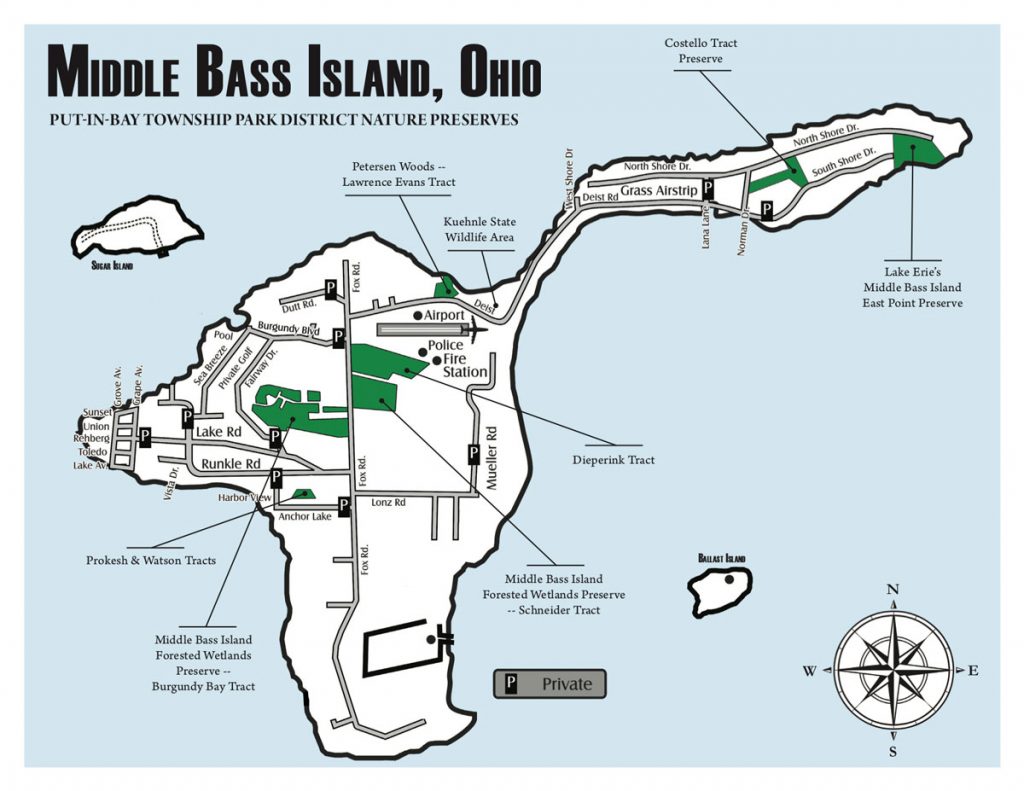Middle Bass Island SP
Middle Bass Island SP
Middle Bass, Ohio 43446
Middle Bass Island websiteMiddle Bass Island map
Middle Bass Island State Park website
Middle Bass Island State Park map
Also, see all the hotspots at:
Lake Erie Western Basin Important Bird Area
Tips for Birding
Middle Bass Island State Park, Petersen Woods, and Kuehnle Wildlife Area are stops on the Lake Erie Birding Trail.
About this Location
Middle Bass Island was formed during the glacial period when massive ice sheets entered Ohio. Glaciers gouged and scoured the bedrock, and their tremendous weight left deep depressions which filled with meltwater, forming the Great Lakes. Lake Erie, the world’s 12th largest freshwater lake, is large in area but shallow, allowing for violent storms with high waves. The western basin, where Middle Bass Island is located, has an average depth of only 25 to 30 feet.
Lake Erie has high nutrient levels and warm temperatures which produce greater numbers and varieties of fish than any other Great Lake. Annual catches nearly equal the combined catch of all other Great Lakes. Yellow perch, smallmouth bass, white bass, channel catfish, and walleye are dominant species. Due to the stabilizing effect of the lake, the Lake Erie islands are also highly productive; despite their extreme northern location, the islands have the longest frost-free period of any area in Ohio.
Middle Bass, as well as the neighboring Lake Erie islands, is composed of limestone bedrock. The island’s glacial past is evident in small scratches in the rock surface, known as glacial striations, carved by rocks embedded in the glacial ice. Vast stands of red cedar and the presence of underground caverns, both associated with limestone, are found here. The islands and shoreline support a variety of reptiles including the state’s highest concentration of the harmless fox snake. The timber rattlesnake was at one time quite prevalent on the islands but is now gone from the area. Rattlesnake Island was so named due to the presence of this reptile years ago.
The Lake Erie water snake, a subspecies of the Northern water snake, comes in a variety of colors, ranging from banded gray and brown blotches to solid gray. This snake has one of the smallest geographic ranges of any vertebrate in the world and is only found on the islands of Lake Erie. The Lake Erie water snake is similar to its relative, the Northern water snake, except that the dark pattern of crossbands is very pale or completely lacking. The general coloration is gray, greenish, or brownish. The belly is white or pale yellow, occasionally tinged with pink or orange down the center. In the summer, snakes prefer to spend time near the water’s edge basking on the rocky shoreline or foraging just offshore. Overwintering sites are typically located within 76 yards of the shore in rocky substrates and are sometimes covered with soil, leaf litter, decaying wood, and grass. Overwintering sites include natural and constructed structures in open and wooded areas. This snake mates from late May to early June by forming “mating balls” consisting of one female and several males. Live birth of 30 or so pencil-sized young occurs in early September. Only about 15 percent of the young survive their first year.
Migrating songbirds rest here before winging across the lake. Hundreds of different species have been identified, making this one of the best birdwatching areas in the country. Several nesting pairs of the magnificent bald eagle are located in the area.
Features
Restrooms on site
Content from Middle Bass Island State Park website

